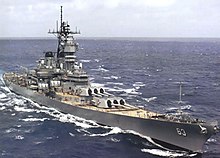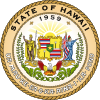Portal:Hawaii
The Hawaii Portal Hawaii (/həˈwaɪ.i/ ⓘ hə-WY-ee; Hawaiian: Hawaiʻi [həˈvɐjʔi, həˈwɐjʔi]) is an island state of the United States, in the Pacific Ocean about 2,000 miles (3,200 km) southwest of the U.S. mainland. One of the two non-contiguous U.S. states (alongside Alaska), it is the only state not on the North American mainland, the only state that is an archipelago, and the only state in the tropics. Hawaii consists of 137 volcanic islands that comprise almost the entire Hawaiian archipelago (the exception, which is outside the state, is Midway Atoll). Spanning 1,500 miles (2,400 km), the state is physiographically and ethnologically part of the Polynesian subregion of Oceania. Hawaii's ocean coastline is consequently the fourth-longest in the U.S., at about 750 miles (1,210 km). The eight main islands, from northwest to southeast, are Niʻihau, Kauaʻi, Oʻahu, Molokaʻi, Lānaʻi, Kahoʻolawe, Maui, and Hawaiʻi, after which the state is named; the latter is often called the "Big Island" or "Hawaii Island" to avoid confusion with the state or archipelago. The uninhabited Northwestern Hawaiian Islands make up most of the Papahānaumokuākea Marine National Monument, the largest protected area in the U.S. and the fourth-largest in the world. Of the 50 U.S. states, Hawaii is the fourth-smallest in land area and the 11th-least populous; but with 1.4 million residents, it ranks 13th in population density. Two-thirds of Hawaii residents live on O'ahu, home to the state's capital and largest city, Honolulu. Hawaii is among the country's most demographically diverse states, owing to its central location in the Pacific and over two centuries of migration. As one of only seven majority-minority states, it has the only Asian American plurality, the largest Buddhist community, and largest proportion of multiracial people in the U.S. Consequently, Hawaii is a unique melting pot of North American and East Asian cultures, in addition to its indigenous Hawaiian heritage. Settled by Polynesians sometime between 1000 and 1200 CE, Hawaii was home to numerous independent chiefdoms. In 1778, British explorer James Cook was the first known non-Polynesian to arrive at the archipelago; early British influence is reflected in the state flag, which bears a Union Jack. An influx of European and American explorers, traders, and whalers soon arrived, leading to the decimation of the once-isolated indigenous community through the introduction of diseases such as syphilis, tuberculosis, smallpox, and measles; the native Hawaiian population declined from between 300,000 and one million to less than 40,000 by 1890. Hawaii became a unified, internationally recognized kingdom in 1810, remaining independent until American and European businessmen overthrew the monarchy in 1893; this led to annexation by the U.S. in 1898. As a strategically valuable U.S. territory, Hawaii was attacked by Japan on December 7, 1941, which brought it global and historical significance, and contributed to America's entry into World War II. Hawaii is the most recent state to join the union, on August 21, 1959. In 1993, the U.S. government formally apologized for its role in the overthrow of Hawaii's government, which had spurred the Hawaiian sovereignty movement and has led to ongoing efforts to obtain redress for the indigenous population. (Full article...) This is a Featured article, which represents some of the best content on English Wikipedia..
USS Missouri (BB-63) is an Iowa-class battleship built for the United States Navy (USN) in the 1940s and is a museum ship. Completed in 1944, she is the last battleship commissioned by the United States. The ship was assigned to the Pacific Theater during World War II, where she participated in the Battles of Iwo Jima and Okinawa and shelled the Japanese home islands. Her quarterdeck was the site of the surrender of the Empire of Japan, which ended World War II. After World War II, Missouri served in various diplomatic, show of force and training missions. On 17 January 1950 the ship ran aground during high tide in Chesapeake Bay and after great effort was re-floated several weeks later. She later fought in the Korean War during two tours between 1950 and 1953. Missouri was the first American battleship to arrive in Korean waters and served as the flagship for several admirals. The battleship took part in numerous shore bombardment operations and also served in a screening role for aircraft carriers. Missouri was decommissioned in 1955 and transferred to the reserve fleet (also known as the "Mothball Fleet"). (Full article...) This is a Good article, an article that meets a core set of high editorial standards.
 Moses Kuaea (c. 1824 – May 5, 1884) was a Native Hawaiian clergyman and politician of the Hawaiian Kingdom. He was pastor of the Kaumakapili Church from 1874 to 1882 and was known as an eloquent preacher. During his time at the pulpit, he helped fundraise for the second building of the church which was completed in 1888 and later burned down in 1900. In 1874, he gave a speech lauding the new elected King Kalākaua prior to his state visit to the United States. After Kalākaua's return to Hawaii, he appointed Kuaea a member of the Privy Council of State and as his Minister of Finance from August 14 to September 27, 1880. After his brief stint in politic, Kuaea returned to preaching at Kaumakapili until his resignation in 1882 due to illness. He died in 1884. (Full article...) Selected Picture - 'Ōlelo (Language) -This section is here to highlight some of the most common words of the Hawaiian Language, ʻŌlelo, that are used in everyday conversation amongst locals.
Mauka
Towards the mountain, in the direction of the mountain State Facts
State Symbols:
Selected article - The COVID-19 pandemic in Hawaii affected all aspects of life in the state, demolishing its economy, closing its schools and straining its healthcare system, even though it experienced far less spread than other US states. Throughout the pandemic, Oahu had the most cases, in absolute terms, although Lanai had the most per capita. Maui and Hawaii followed Oahu, trailed by Kauai. Hawaii consistently ranked among the most-vaccinated of US states. (Full article...) Did you know? -
Hawaii News
Wikinews Hawaii portal
Quotes - "I am always telling our federal agencies and contractors that if they bring work to Hawaiʻi, they need to hire Hawaiʻi residents." — Senator Daniel Akaka On this day...There are no anniversaries listed for this day. Related portalsTopicsCategoriesAssociated WikimediaThe following Wikimedia Foundation sister projects provide more on this subject:
SourcesDiscover Wikipedia using portals |
























